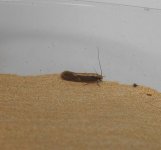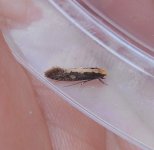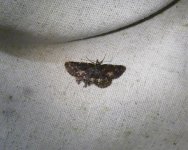-
Welcome to BirdForum, the internet's largest birding community with thousands of members from all over the world. The forums are dedicated to wild birds, birding, binoculars and equipment and all that goes with it.
Please register for an account to take part in the discussions in the forum, post your pictures in the gallery and more.
You are using an out of date browser. It may not display this or other websites correctly.
You should upgrade or use an alternative browser.
You should upgrade or use an alternative browser.
July Moths GB&I (1 Viewer)
- Thread starter smokenack
- Start date
More options
Who Replied?honeym
Well-known member
It's certainly shown that way in Sterling & Parsons (but they don't mention it as a feature), but it wouldn't help here, or in the majority of specimens that I see, as the fringe is usually worn away.
Something to look at if I ever get a fresh specimen.
Thanks for that.
Martin
Something to look at if I ever get a fresh specimen.
Thanks for that.
Martin
honeym
Well-known member
Hi
No Monopis last night but did get a new tineid for the site, Tinea semifulvella.
75 species in total, some of which are still to identify and, as just mentioned on the moth id forum, the most numerous was the aquatic crambid Acentria ephemerella, with 165 specimens.
Martin
No Monopis last night but did get a new tineid for the site, Tinea semifulvella.
75 species in total, some of which are still to identify and, as just mentioned on the moth id forum, the most numerous was the aquatic crambid Acentria ephemerella, with 165 specimens.
Martin
The annual Bird Cherry Ermine invasion is in full swing, 195 last night. I think they come from our local cemetery about half amile away where there is a huge population, trees and grave stones covered in webbing.
76 species a couple of nights ago was my best night ever.
Plumed Fan-foots still nightly and for the first time two last night actually in the trap. I've only had singletons before and very rarely inside the trap. I wondr where the local population is, I presume these haven't wandered far.
76 species a couple of nights ago was my best night ever.
Plumed Fan-foots still nightly and for the first time two last night actually in the trap. I've only had singletons before and very rarely inside the trap. I wondr where the local population is, I presume these haven't wandered far.
honeym
Well-known member
HiPlumed Fan-foots still nightly and for the first time two last night actually in the trap. I've only had singletons before and very rarely inside the trap. I wondr where the local population is, I presume these haven't wandered far.
I think the available information on the Plumed Fan-foot is in need of up-dating.
ukmoths and hants moths state that it is "A rare migrant, mainly to the south-east coast of England, with less than a dozen records since the first in 1995".
Whilst it'is migrant status is probably correct, it is also certainly well established in the UK - in Essex, N. Kent and in London (at least). I get it at two sites (S. Kensington [since 2009] and Barnes [since 2015]) and I know it is frequently trapped at a site in Westminster and a couple more sites in central London.
I expect you are near one of the population centres so I would regard them as a local resident.
Martin
Hi
I think the available information on the Plumed Fan-foot is in need of up-dating.
ukmoths and hants moths state that it is "A rare migrant, mainly to the south-east coast of England, with less than a dozen records since the first in 1995".
Whilst it'is migrant status is probably correct, it is also certainly well established in the UK - in Essex, N. Kent and in London (at least). I get it at two sites (S. Kensington [since 2009] and Barnes [since 2015]) and I know it is frequently trapped at a site in Westminster and a couple more sites in central London.
I expect you are near one of the population centres so I would regard them as a local resident.
Martin
I've had 15 records, 1 in 2014, 5 in 2015 and 9 so far this year. Generally late June to late July with one record in September last year.
honeym
Well-known member
I've done a bit of searching and, not including totals from areas where I know it is established, I've come up with 53 records. Way more than less than a dozen, as stated. It will be interesting to see what the final figure will be, once I've been through all the 'migrant' reports, etc.I've had 15 records, 1 in 2014, 5 in 2015 and 9 so far this year. Generally late June to late July with one record in September last year.
Martin
KenM
Well-known member
Am now turning the trap light off at midnight (NE.London)...as I'm finding the resulting ''slaughter'' in the morning by the resident Robin to be too much!
Although there is a substantial drop in species, there are still a few gems to be found during the course of the evening.
This is the third example that I've had within the last few years, I presume that they are on the increase?
cheers
Although there is a substantial drop in species, there are still a few gems to be found during the course of the evening.
This is the third example that I've had within the last few years, I presume that they are on the increase?
cheers
Attachments
I've done a bit of searching and, not including totals from areas where I know it is established, I've come up with 53 records. Way more than less than a dozen, as stated. It will be interesting to see what the final figure will be, once I've been through all the 'migrant' reports, etc.
Martin
They are still coming, 3 last night including one dead in a spider's web.
Steve Lister
Senior Birder, ex County Recorder, Garden Moths.

My trap results this year have been largely forgettable but last night produced two new species for my garden - Double Lobed and July Highflyer.
Last Tuesday (12th) my trap sadly attracted and killed c130 Water Veneers, despite being well away from any water.
Steve
Last Tuesday (12th) my trap sadly attracted and killed c130 Water Veneers, despite being well away from any water.
Steve
honeym
Well-known member
Hi SteveLast Tuesday (12th) my trap sadly attracted and killed c130 Water Veneers, despite being well away from any water.
Steve
This isn't being callous but please don't blame yourself, or your trap, as they would have died anyway. They have an unusual life-history and the adults live for, at most, two days. After mating, each female lays between 100-300 eggs, a huge number for such a relatively small moth. Given that the moth's life history is almost totally aquatic, I've never read an explanation of what you have observed - large numbers of moths so far from any water. Only a few winged females are produced, so I imagine that most males stay close to the water where they emerged in order to mate with the wingless females. These winged specimens must be dispersing in order to find new habitat.
If anyone's ever read more on this I'd be interested to hear.
Martin
Paul Chapman
Well-known member
Possibly a result of predation leading to an imbalance of the sex ratio and therefore the wanderlust (literally) of the winged males in the absence of unmated local wingless females??
Experimental evidence for a strong influence of stickleback predation on the population dynamics and sex ratio of an aquatic moth
Full-text Article · Dec 2008 · Fundamental and Applied Limnology / Archiv für Hydrobiologie Oliver Miler Michael Korn Dietmar Straile
In my trap, a Garden Tiger was pleasing this morning and a friend's Small Ranunculus cements its ongoing local status.
All the best
Experimental evidence for a strong influence of stickleback predation on the population dynamics and sex ratio of an aquatic moth
Full-text Article · Dec 2008 · Fundamental and Applied Limnology / Archiv für Hydrobiologie Oliver Miler Michael Korn Dietmar Straile
In my trap, a Garden Tiger was pleasing this morning and a friend's Small Ranunculus cements its ongoing local status.
All the best
Having only started trapping in my own garden last moths I have had quite a few new species in July. Highlights for me have been large emerald, nut tree tussock, leopard moth, magpie moth, drinker and coronet. Away from home I have also had my first antler moths which are real stunners.
About 20 miles from me another local mother had a surprise in their trap on Sunday morning in the shape of Microloxia herbaria. Seems to be the first UK record.
About 20 miles from me another local mother had a surprise in their trap on Sunday morning in the shape of Microloxia herbaria. Seems to be the first UK record.
honeym
Well-known member
About 20 miles from me another local mother had a surprise in their trap on Sunday morning in the shape of Microloxia herbaria. Seems to be the first UK record.
Now that is a surprise as it has a very southern distribution and mainly coastal round the Med. (I get it in Mallorca), a liitle more inland in eastern Europe.
Not a species I would associate with lorg distance migration.
When I search for it on Google I get an Atropos Guestbook link - but it's not there on the web page.
Martin
Last edited:
Now that is a surprise as it has a very southern distribution and mainly coastal round the Med. (I get it in Mallorca), a liitle more inland in eastern Europe.
Not a species I would associate with lorg distance migration.
When I search for it on Google I get an Atropos Guestbook link - but it's not there on the web page.
Martin
I didn't see it myself and the finders photos are only on a closed FB page as far as I know. Here is a link to a photo on Twitter - https://mobile.twitter.com/JLowenWildlife/status/757500676658331650 It was retained and is heading to the county recorder for verification.
Also in county at the weekend were two records of Metalampra italica not sure how relevant movement of one woud be to the other.
Hi everyone, I had a few good new moths over the weekend in SW London, including a Gypsy Moth (dark form). I did a bit of research and started thinking I'd found something unusual, then read online that a population now exists in London and it's trapped regularly. Does anyone know anymore about this increase in records?
Similar threads
Users who are viewing this thread
Total: 2 (members: 0, guests: 2)






